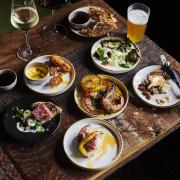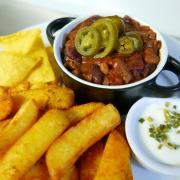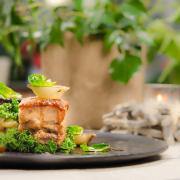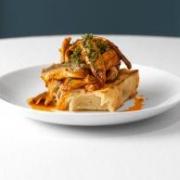As World Health Day approaches on April 7, we speak to Kent-based chefs who explain why eating healthy is important, their healthy food heroes, and reveal some of the tasty offerings on their spring menus.

Will Devlin, chef owner, The Small Holding, Kilndown.
“Healthy eating can sometimes be confused with diet culture, which is restrictive and ultimately, unhealthy. Healthy eating is about filling your plate with nutritious whole grains and vegetables that, ideally, are seasonally and locally grown. Eating good food that is ethically and sustainably grown is always going to be the healthiest option.”
Is it vital chefs know where their produce comes from?
“When I was a chef in London the disconnect between the food we were cooking and where it had come from and who had grown it was so strong that it was unsustainable for me to continue working like that. Growing our own ingredients at The Small Holding’s farm has been transformational. Yes, I could buy ingredients that would be cheaper and much less hassle than growing them, but they would never be as tasty or nutrient rich and good for you.”
The unsung healthy ingredients providing flavour?
“Herbs are a vital ingredient which can add so much to dishes and are packed with vitamins and minerals. We grow so many herbs from parsley and basil to more unusual, difficult to buy herbs, such as chervil and winter savoury and all kinds of mint with interesting flavour profiles. We use herbs to infuse cream, make into herb oils, and even use in cocktails.”
What’s to look forward to?
“April is the time to get outside and go foraging, it’s a natural larder of wild and free food. Take a good identification guide with you and look for elderflower, wild garlic, young nettles chickweed and sorrel. These wild foods are nutrition powerhouses, will supplement your cooking and all with the added benefit of getting outdoors and reconnecting with nature.”
Where you find your inspiration?
“The one acre of land we have that feeds The Smal Holding’s kitchen is the driving force of the restaurant and we always say it’s the farm that writes and dictates the menu, not us. I love the challenge of creating new dishes from what’s in season – a race in the summer when we’re harvesting every day, through to the leaner winter months when we rely on our larder full of preserves, pickles, oils, and ferments to add layers of flavour and complexity. What grows together really is the best form of inspiration, from the classic pairing of tomato and basil, or more unusual flavour combination such as courgette topped with peppery nasturtium leaves and flowers.”
thesmallholding.restaurant.com

Georgeta Negoita, head chef, Little Rock Folkestone.
“Taking good care of your health is like giving yourself a little daily dose of love. When you consume healthy and nutritious food, you're not just keeping diseases at bay, but also giving your mind a high-five. Adopting a balanced and nutritious diet can have long-lasting benefits for individuals and communities.”
Is it vital chefs know where their produce comes from?
“It’s very important as it helps us to know the quality and flavour, seasonality, sustainability and traceability.
“Understanding the origin of produce helps us to align our menu with the seasons, ensuring we are using fresh, in-season ingredients.
“By sourcing ingredients from local farmers and suppliers we can support sustainable agricultural practices, reduce the environmental impact of transportation and contribute to the local economy.
“We are proud to source our produce from local suppliers: Folkestone Trawlers (fish and seafood), Foodari (fruit and veg) and Docker Bakery (supplying fresh daily sourdough).”
The unsung healthy ingredients providing flavour?
“Several ingredients can add flavour to dishes while also providing health benefits. For example: Fresh herbs such as parsley, basil, cilantro and mint not only add fresh, bright flavours to dishes but also provide vitamins, minerals and antioxidants.
“Ginger is known for its spicy, pungent flavour and has anti-inflammatory and digestive health benefits while garlic not only adds a distinctive flavour to dishes but also contains compounds that may have beneficial effects on heart health and immune function.
“Turmeric, this vibrant yellow spice, contains curcumin which has powerful anti-inflammatory and antioxidant properties and citrus zest such as lemons, limes and oranges contain flavourful oils that can enhance the taste of dishes without adding extra calories.”
What’s to look forward to?
“Spring offers a bounty of fresh, flavourful ingredients that can inspire a wide range of dishes. I'm looking forward to celebrating the season with menus that highlight the best of what spring has to offer, from vibrant salads to light, refreshing desserts.
“Asparagus – this versatile vegetable is a springtime favourite, and I'm excited to use it as much as possible in our dishes. It is not only delicious but also a good source of vitamins, minerals, and fibre.
“Sweet, tender fresh peas are a delightful spring ingredient that can be used in a range of dishes, from soups and risottos to salads and side dishes. They add a pop of colour and a burst of flavour to springtime menus.
“Juicy, sweet strawberries are a hallmark of spring, and I'm eager to feature them in desserts, and salads. They are rich in vitamin C and antioxidants, making them a healthy and flavourful addition to spring menus.
“With an array of fresh greens, herbs, and vegetables becoming available, I'm looking forward to creating vibrant and nutrient-packed spring salads that celebrate the flavours of the season. From baby lettuces to radishes and fresh herbs, spring salads offer a delightful variety of textures and flavours.”
Where you find your inspiration?
“I find inspiration for new menu options in a couple of places! First and foremost, it's all about our amazing customers. Customer's preferences and feedback are like my creative compass, guiding me to whip up dishes that match their cravings and exceed expectations.
“I also take a delicious journey through the global culinary landscape, drawing inspiration from talented chefs worldwide. Cookery books are like my treasure trove of knowledge and creativity, sparking ideas and shaping the tasty wonders you find on our menu.”
littlerockfolkestone.co.uk

Sasha Cooper, head chef, The Five Bells Inn, Brabourne.
“Healthy eating is always important, sometimes it can feel like a daunting task when quick ready meals are easily available or the feeling of ‘I’m not sure how to cook that’ washes over you. But just trying to stick to a well-balanced meal is an easy way to start on the track of healthy eating or choosing a vegetable or fruit snacks over ‘junk’ foods.
“We try to ensure we always have well balanced dishes on our menus, along with multiple homemade vegan options to help customers choose. We cook in a style where we initially reduce added ingredients such as butter not only helping us provide lactose-free dishes but also creating dishes that are healthier.”
Is it vital chefs know where their produce comes from?
“I’ve always found it vital for chefs and, well, anyone to know where their produce comes from where possible. We have always tried to use local farmers and suppliers to ensure sustainability and seasonality. Using local suppliers tends to be smaller farms so you know ingredients have had the most love put into it, whilst also helping to reduce carbon footprints and environmental impact.
My favourite part of cooking within seasons, is when our local fruit and vegetable supplier (Foodari) lets you know that due to good weather conditions certain ingredients are at their best and the excitement of new seasons starts bringing new ingredients to play with.”

The unsung healthy ingredients providing flavour?
“Wild Garlic is my favourite ingredient of spring. Much like asparagus, it has a short season, and an ingredient that helps you get outside and take part in some local foraging found in woodland areas, every part of the plant can be used. Like standard garlic, wild garlic brings a big punch of flavour whilst helping to reduce blood cholesterol levels and lowers blood pressure, good to use in almost everything from salad dressings, soups, or simply adding to homemade breads. In the kitchen, we try to extend the season by making pesto’s and purées to help preserve it for use across spring and summer menus.
“Along with wild garlic, April brings the start of locally grown lettuces for all our salad-based dishes to help balance our menus adding extra healthy options.”
What’s to look forward to?
“Spring brings asparagus season and you’ll see this ingredient being used on every menu across the country, due to its short season but also for its amazing health benefits, being packed with vitamins, minerals and antioxidants. Its season is something us chefs are always looking forward to, along with crab helping add a fresh flavour to the menu especially when we have local Folkestone Trawlers supplying us.”
Where you find your inspiration?
“Inspiration for new menus and dishes often comes from going out and trying new restaurants, talking to other chefs within the company and generally just playing about with new ingredients in the kitchen.”
fivebellsbrabourne.co.uk

James Pilcher, head chef, The Ferry House, The Isle of Harty.
“Everyone understands eating healthily is important for the good of our body, however, it is more than just eating more fruit and veg, it’s also about making better food choices. Choosing higher welfare meats and knowing our food provenance often has environment benefits which go hand in hand with health benefits. For example, choosing meats that are not loaded with antibiotics or have been unnaturally fattened, and choosing fresh produce which has not been over-sprayed with chemicals.
“We serve wild game from our own estate. It has various health benefits including being higher in Omega-3 fatty acids and lower in cholesterol. Their lifestyle leads to another huge benefit; the absence of steroids, antibiotics and other additives found in intensively farmed animals.
“Using beef from the Burden’s (owners) family farm, the cattle is incredibly high welfare, grass grazed on 3,000 acres of natural, pesticide-free pasture at the nearby Elmley Nature Reserve. Grass provides slow, natural growth and optimal nutrition to the herd and also makes for high quality, well-marbled beef, so not only tastes better, it’s infinitely better to put in your bodies!”
Is it vital chefs know where their produce comes from?
“We have close relationships with quality growers and producers throughout Kent. If the producer is as passionate as you are about the product and works to the same level, it gives you a new level of respect for the produce. It affects your attitude towards not wasting any part of it, and ensuring as much as possible can be creatively used. It’s a relationship that only benefits everyone involved and these kinds of relationships should always be fostered.”
The unsung healthy ingredients providing flavour?
“Lots of fresh produce that doesn’t suit the commercial industry isn’t readily available and so we don’t get to try it! Maybe it is perishable, doesn’t transport well, or needs to be handpicked so is cost prohibitive, these are challenges we don’t have to work around when we crop daily from our own garden.
“We’re really excited to include Oca tuber, part of the oxalis family. They are a sorrel with a clover shaped three leafed pattern. They have a sharpness and tartness to the flower and the leaves and a tuber that is starchy with a high nutritional value. They’re incredibly flavoursome… a sweet and tart, citrusy flavour and can be eaten raw.
“Pineapple guava is also intriguing. It’s a type of guava, but it produces a flower first. The petals are edible, soft and marshmallowy, an unusual flavour with a pillowy texture.”

“White asparagus, our regular asparagus and wild garlic. When it’s time to crop this produce from the garden it’s exciting…‘spring is here at last’. A very short season, you’re just excited to make the most of it and fresh from the garden daily, it is, in our opinion, the tastiest. We produce our own white asparagus by ‘forcing it’ and it is more subtle and nutty, than green, and more fibrous. As for wild garlic, it also has a short season and wilts quickly when picked. It is a good one for us to ferment and preserve. We pickle our wild garlic stems and make capers from the seed and flower pods. Look out for our smoked pork belly dish, likely to be on the menu again this coming season and uses both asparagus and wild garlic.”
Where you find your inspiration?
“Often from books, but not necessarily cookbooks, more like ‘technique’, text book-style and they could be on fermentation, or different preservation techniques, often a technique I’ve not tried yet and am interested in. They are often not from British chefs using British produce but that doesn’t mean you can’t try the technique on something else. For example, I once saw a ‘salted plums’ technique from a Japanese chef and tried it with salted apricots instead.
“We always have an exciting larder of creatively preserved produce and kept by-products based on these techniques we experiment with, we waste nothing. This lets us experiment, pair produce and decide what it needs to pull it together into a dish…call it a repertoire of techniques and flavours.
“Yes, the menu is garden led by what we have planted and there is a sense you are planning the dishes based on the seeds and cuttings of 12 months ago, however, there is also an exciting element of spontaneity to the menu.
“Dishes can be planned far in advance and then tweaked, or they are born of a collection of a few interesting items we have in our larder, that just work well together.
“We love to create twists on things that have been done, just because we can. There is something satisfying about taking a classic dish and making it ours.”
theferryhouse.co.uk

Recipe from Will Devlin…Courgette Bhaji, nasturtium and chilli
Served in the height of summer as part of a dish with different courgette treatments including roasted and puréed, the finished plate is dressed with chilli oil and nasturtium leaves and flowers.
Makes approx. 20
Ingredients
For the bhaji
Five medium courgettes
170g gram flour
½ teaspoon garlic powder
½ teaspoon onion powder
½ teaspoon ground cumin seeds
15g salt
80ml sparkling water
1 litre of sunflower oil to fry
Method
For the bhaji peel, grate and salt four of the courgettes. Save the peelings and squeeze the grated courgette of excess liquid.
Mix the grated courgette with the other ingredients, except the sunflower oil, to form a batter.
Heat the sunflower oil to 175 degrees.
Using a tablespoon scoop a spoonful of the mixture into the hot oil and fry for a minute or so each side until golden brown.
Make a courgette sauce by sautéing the peelings hard and fast in a little rapeseed oil and butter with the lid on to create steam. When just tender and still hot, whiz in a blender and season.
Slice the remaining courgette into thick rounds, season and brush with a little chilli oil. Roast until soft and just charred
To plate
Drain each bhaji on kitchen paper and serve hot with a spoonful of courgette purée, pieces of roasted courgette and dress with chilli oil and nasturtium leaves and flowers.



























